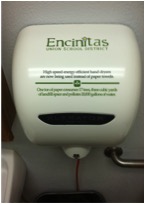By. Timothy B. Baird, Ed.D., Superintendent, Encinitas Union School District (California)
Background
For the past seven years, the Encinitas Union School District (EUSD) has invested millions of dollars and thousands of hours into transforming itself into a green school district. The District has purposefully addressed energy use by installing solar panels and solar tubes, upgrading roofing and windows, and replacing inefficient air conditioning and heating units. As we focused on reducing our waste stream, we moved toward zero waste by purchasing two SCRAP carts to separate lunchtime waste, sending recyclable material to the recycle bin and compost material to the right compost bin, and ultimately to the school garden. Water use has been reduced through more efficient watering systems, the use of drought resistant plants, and water harvesting on all campuses. Green changes were made in these areas and in others across the District. Today, EUSD uses less energy and materials and has a greener carbon footprint than at any time in our history. Yet, we are still not sure whether these system changes are enough. As a result, we are striving to shift the thinking of our students, staff, and community to transition from being green observers to environmental stewards.
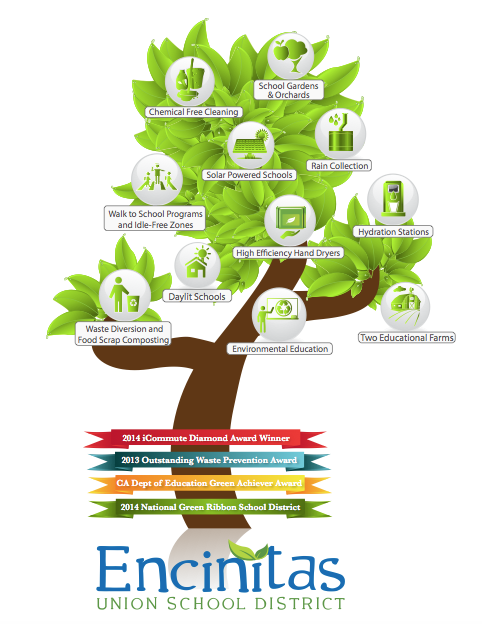
The Cognitive Construct
EUSD uses a simple learning model to move learners from awareness to action. We call it our Cognitive Construct. The ideas within the Cognitive Construct are easy to grasp. Learners move from Acquisition of knowledge and skills to Analysis and ultimately Application. The Cognitive Construct also moves the learner from simple to complex learning in each area and from artificial to real world learning issues. The goal is to have all learners (students, staff, parents, and community) apply learning in complex, real world settings.
Acquisition of Knowledge and Skills
Acquisition of knowledge and skills is an important step in the overall process. If learners do not understand what we are doing to make EUSD greener and ultimately why we are making these changes, we have not really made the impact we are trying to achieve. So the first step in our process to create environmental stewards is to build awareness and understanding. We started with classroom education and learner training around some of our initiatives. This was a good beginning. We expanded our outreach in this area through educational signage. By using signage to draw attention to green initiatives, we immediately gave context and relevance for the change. Here are some examples:
Analysis and Application Skills
From acquisition of knowledge, we moved to the next level of learning, which was to create learning scenarios where students would have to analyze and ultimately apply the knowledge and skills they were gaining around our green initiatives. Because these were real changes in our work and environment, students saw the real world context clearly.
Many of our projects began with a simple question. “How can we reduce our lunchtime trash going to the landfill?” “Why don’t more students walk to school?” “Can we reduce our energy use at our school?” Questions such as these, and others like them, lead to students acquiring knowledge to answer the question, and then moving forward to analyze their findings and apply what they learned.
Here are some examples:
Stormwater Pollution Prevention Plan
As with most of these projects, the idea behind this is simple. EUSD is required to develop a Stormwater Pollution Prevention Plan. In the past, we would hire a consultant who would do the research, formulate a plan, and file the required paperwork with county and state authorities. We still used a consultant to help, but the work of the consultant shifted. Now they are charged with having teams of 5th and 6th graders at different schools do the research, develop the plan, and share the findings. The results have been amazing. Although the design is slightly different at some of our schools, they all use the same basic structure. Essentially, students step into the role of scientific interns. They assist in various ways depending upon their role. They begin by understanding the impacts of stormwater runoff and how destructive pollutants can be in our nearby ocean. This leads to analysis where they take water samples, measure pollutants, and look for common problem areas. Finally, they develop an improvement plan. This plan tries to use system and behavioral change to address the problem. The plan is written in a professional manner, best practices are called out, a budget is developed, and then the students are ready for presentation. Our students have presented their plans to our school board, the county board of supervisors, and other governmental agencies. We are now funding their plans and students are ensuring that all projects are completed as designed and are getting the desired outcome.
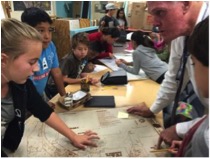
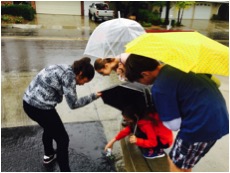
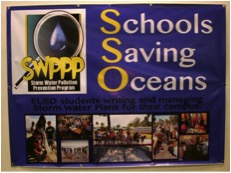
Energy Teams
Addressing energy issues at our schools has been a high priority for EUSD. The result is a robust plan to install photovoltaic solar panels, solar tubes, and other energy efficient building upgrades to create a system that is designed to use less energy and save money. These projects are all natural starting points for student learning. Rather than just teach our students about these energy saving upgrades though, we put forth a challenge. Can we do more to reduce our energy use at schools that have implemented all of these changes?
Again, different schools addressed this challenge in different ways, but there were some common elements. It started again with acquisition of knowledge. Students had to learn about energy and how the new systems worked. They then had to analyze what impact these systems were having and where there was still room for improvement. This involved taking light reading measurements, analyzing electric bills, and assessing how the school was utilizing the new solar tubes. The next step will be for the student energy teams to write up a recommended improvement plan. Improvement plans will include further system improvements and behavioral and educational training factors such as not leaving doors open when the air conditioner is running. Students will then present their plans to our school board for approval and will ultimately be tasked with implementing the plans and measuring the improvements.
Other Projects
This type of learning has been used for a variety of green efforts. Student scientists at one of our schools tested the air quality in front of their school with graduate students from a local university. Their findings led to an anti-idling campaign for parent drivers picking up students at all of our schools. Our schools have student green teams that supports all aspects of recycling and composting for their respective campuses. Students volunteer for these roles and often follow up on projects on their own time. We are seeing new student driven research studies starting up all over the district.
Conclusion
Student learning that is built around real world application and is focused on increasing environmental stewardship can be a powerful catalyst for change. The process for developing these student work groups is surprisingly easy:
- Start with a question or challenge
- Focus on real world issues – make the learning purposeful
- Begin with Acquisition of knowledge and/or skills needed to do the work
- Transition to Analysis and ultimately Application
- Present the findings and plan to an authentic audience (use adults whenever possible)
- Implement the plan and measure results
With these simple steps any teacher, school, or district can make significant strides in improving the environment and empowering their students to tackle real world learning challenges.
About Dr. Timothy Baird
The Encinitas Union School District (EUSD) has a long-standing reputation of high student achievement and has been acknowledged for its innovative learning opportunities. As Superintendent, Dr. Baird’s leadership in green initiatives and environmental stewardship has garnered state and national recognition for conservation efforts, including selection by the U.S. Department of Education as a National Green Ribbon District. Dr. Baird led the implementation of a one-to-one digital learning program, which includes a suite of digital curriculum, and earned the district recognition as an Apple Distinguished Education Program. In addition, EUSD maintains an award-winning, comprehensive Health/Wellness Program that incorporates yoga and character education.

